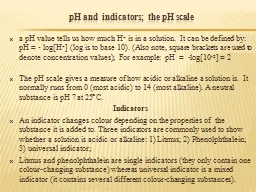PPT-pH and indicators; the pH scale
Author : luanne-stotts | Published Date : 2017-05-22
a pH value tells us how much H is in a solution It can be defined by pH logH log is to base 10 Also note square brackets are used to denote concentration
Presentation Embed Code
Download Presentation
Download Presentation The PPT/PDF document "pH and indicators; the pH scale" is the property of its rightful owner. Permission is granted to download and print the materials on this website for personal, non-commercial use only, and to display it on your personal computer provided you do not modify the materials and that you retain all copyright notices contained in the materials. By downloading content from our website, you accept the terms of this agreement.
pH and indicators; the pH scale: Transcript
Download Rules Of Document
"pH and indicators; the pH scale"The content belongs to its owner. You may download and print it for personal use, without modification, and keep all copyright notices. By downloading, you agree to these terms.
Related Documents














